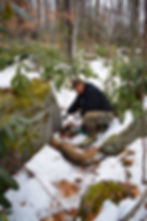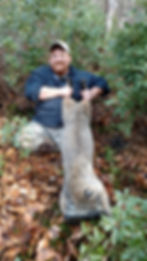
The late legendary trapper Johnny Thorpe probably described bobcats best when he wrote: "He's a lazy, worthless, weed-smokin' sort, who has nothing to do an' all day to do it. This in no way makes him a bad person, just different -- a square peg in a round hole. Bobcats are uncaring and unpredictable, but that doesn't make them stupid by any means. Remember, you're nobody until you've been ignored by a 'cat!"
One reason bobcats have gained this reputation is because they have short attention spans. If you want to catch bobcats, you have to grab their attention enough to make them want to work your set. That's not always easy to do, especially in areas east of the Mississippi. The terrain and travel ways here are less defined and good habitat is more abundant than in the western United States, which means movement through an area can be more sporadic. I've trapped whole seasons (which runs three weeks here in Pennsylvania) when a bobcat passed through prime habitat only once or twice. If I don't get him that first time, well, I guess it's better luck next year.
There are three keys to consistently catching bobcats. First, find good locations where bobcats are already traveling. Second, construct simple sets with enough blocking so that the animal steps exactly where you want it to step. Three, add eye appeal and flagging.

(Photo: After a fresh snow is a great time to locate Bobcat tracks.)
The Purrrfect Location
When scouting for places to trap bobcats, I look for specific terrain features that provide a natural funnel where bobcats are already passing through. Ridges and drainages are just two examples. Bobcats follow these like road maps. And when I find structure along one of these features, I know I’ve found a hot spot.
For instance, one of my favorite locations is a ridge that’s intersected by a powerline. Vehicle-sized rocks dot the upper portion of the hillside and the top of the ridge. Oddly enough, both sides of this powerline are mostly open woods with hardly any structure at all, which makes those rocks that much more appealing. They’re a magnet for every bobcat in the area.
Any cluster of huge rocks in bobcat country is worth checking out as the thick brush that grows up among them harbors tons of prey species. It’s important to understand that bobcats hunt differently than coyotes. Whereas coyotes typically run on the open side of edges, bobcats are more apt to hug the cover, using it to camouflage their movements as they ambush prey. In that regard, bobcats in the east are no different than those in the west. They gravitate to cover.
Bobcats, like most species, also prefer edges. In the mountain country where I trap, a lot of timbering has taken place over the past 20 years. The perimeters of these cuts are prime locations, especially where they border ridges and drainages, because they generally have thick cover where mice, rabbits, and other small game live.

(Photo: A typical Bobcat location in the Big Woods.)
It’s often said that variety is the spice of life, and that certainly holds true with bobcat trapping. Any time I find where multiple types of habitat meet multiple terrain features, I expect to find ‘cat sign. Take, for example, a rocky ridge that’s recently been timbered. You know that bobcats are running it, but where do you set up?
In this instance, I consider the topography of the land. Is there a low gap on that ridge? Are there rocks near that low gap? What other types of habitat are present nearby?
A couple of years ago, I encountered this type of location on my trapline. When trying to decide where to set, several locations popped out at me. The first was where a dry drainage intersected the ridge to create a low gap. The second was a cluster of rocks further out the ridge. The third was where three types of habitat (mountain laurel, mature hardwoods, and the timbered area) all met on the logging road that had been used to access the area. An added benefit was that the DCNR had installed a fence around the perimeter of the cut to keep deer out so that the forest could properly regenerate.
Without question, this was a bobcat hub. But with so many great set locations to choose from, which one did I decide to set? All of them!
No matter where it is, when I find a bobcat hotspot, I set heavily and don’t rely on just one or two traps to do the job. Bobcats are wide-ranging animals that may only travel through an area once every couple of weeks. When one does pass through, I want as many chances at it as possible.
Sets and Blocking
It doesn’t take a fancy set to attract bobcats. Dirthole sets, flat sets, walk-through sets, cubbies, and trail sets all have their place in the bobcat trapper’s arsenal. What I’ve learned, though, is that bobcats are like that know-it-all friend we all have in our lives, the one who won’t do anything unless you make it seem like it’s their idea. Bobcats are no different. You can’t force them to do anything or go anywhere that they don’t want to, which is why location is so important. No matter what type of set you decide to use, the closer you can construct it to where the ‘cat is already walking, the more effective it will be.
When I first roll up to an area that I want to set, I focus on the first thing that catches my eye. For instance, if I’m looking down an old logging road between a fresh cut and mature timber, I pay attention to any rocks or logs that stand out more than the rest, or, ideally, jut out slightly into the lane. Experience has taught me that bobcats walking that old road will swerve to rub up against that rock or log, marking their territory as they pass by. Most times, they won’t even break stride as they’re doing it. These are natural set locations. And if I don’t find any such rocks or logs along trails where I know bobcats are traveling, I have no problem importing an object that can be used as a scent post, such an old log, and doctoring it up with urine or gland lure.

One of the reasons I like rock outcroppings so much is that the rocks themselves act as funnels. Bobcats will walk the trails tight up against the rocks, once again offering a set location that doesn’t require any additional lure or bait to be effective.
Even when I make dirtholes and flat sets, I try to make them right on the trail where I expect bobcats will be traveling. In my experience, this is the true key to bobcat trapping success. They have short attention spans and show an unwillingness to go out of their way for just about anything unless they have to. A great way to figure out exactly where bobcats are traveling is to go out after a fresh snow and look for tracks. Most times, a bobcat uses the same trails every time it passes through an area, and it will show you exactly where you need to make the set.
Once I make my set, I use heavy blocking to get them to step where I want them to step. Blocking can be any rocks or sticks placed around the set to guide the animal’s foot onto the trap pan. The average stride of a walking bobcat is around seven to nine inches. Of course, that can vary depending on the size of the individual, terrain, and speed at which it’s traveling, but as a general rule, I space my guide sticks seven to nine inches apart at the set, too. Narrower than that and bobcats tend to just step over the whole set. Wider than that and it becomes too hard to predict exactly where the bobcat will place its foot.
Bobcats typically don’t linger long at a set – it’s that short attention span thing again. More often, they’ll adjust their gait speed and direction to pass close to your set and sniff it, paw it, or rub against it as they continue on down the trail. Blocking helps you better predict where their foot will land as they pause to investigate your set.
Flagging and Eye Appeal
In states where legal, using feathers, bones, and bait piles around your sets can be extremely effective at pulling in bobcats. First and foremost, bobcats are sight hunters. They’re relatively cold-nosed animals, not as sensitive to lures and baits as coyotes, but visual attractors can definitely be their downfall.

(Photo: My personal best Bobcat, a 36-pound male taken in a blind set on a trail.)
Unfortunately, in Pennsylvania it is illegal to use any exposed bait, feathers, or animal parts that are visible from the air. However, I’ve found that other types of flagging, such as tinsel, cloth strips, and compact discs, work just as well.
The idea of flagging is to pull bobcats in closer to investigate your sets. For this reason, it’s important to use flagging that’s hard for the animal to identify from a distance. After all, if a bobcat can see from 50 yards away that it’s just a strip of tinsel, then there’s really no need to move in closer to check it out. If using tinsel and cloth, I cut them into two- or three-inch pieces and attach them to a tree branch a foot or two above the set with a strand of monofilament fishing line or cord. The only disadvantage of these lighter materials is that they tend to blow so much that they wrap around whatever structure you’ve tied them to. In many cases, the heavier compact discs are a better option because they tangle less often, and when the wind hits them, they twirl and flutter, reflecting light like a beacon drawing in bobcats. Once I have the bobcat at my set, I rely on quality lures and baits to seal the deal.
Conclusion
Bobcats aren’t hard to catch. In fact, the best virtue any ‘cat trapper can possess is patience. Bobcats do things on their own time, their own schedule, and it can be frustrating trying to wait them out. I’ve seen whole weeks pass by with very little activity, and then a storm front blows through and suddenly there are ‘cat tracks everywhere. That’s just their nature. The challenge is to keep making sets in prime locations, and with lots of eye appeal, so that you’ll be ready for them next time they do decide to move.
______________________________
Want to learn more about trapping bobcats? My trapping partner Rich Faler and I have produced a DVD called "Late Season Mountain Trapline" in which we show you how to catch bobcats, fishers, coyotes, fox, and raccoons during adverse weather conditions. The video is 100% filmed on public land in Pennsylvania. To read more about it, CLICK HERE.
